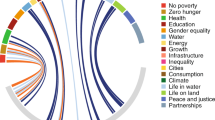Summary
This paper examines the historical development of policy in The Gambia through an analysis of 3 recurring themes: the motivation for keeping livestock, growth of the cattle population and the resulting feed deficit, and the need to develop a mixed farming system. The paper argues that there are major discrepancies between the common understanding which emerges from these themes and the realities of livestock ownership and production. It is suggested that it is because of these discrepancies, that livestock policies and programmes, other than mass disease control, have seldom had their desired impacts.
Résumé
L'article étudie le dévelopment historique des politiques en Gambie à travers une analyse de trois thèmes habituels: la motivation pour la conservation due bétail; la croissance de la population bovine et le déficit inhérent de l'alimentation; le besoin de développement d'un système d'élevage mixte.
L'article démonte qu'il existe d'importants décalages entre la compréhension commune qui émerge de ces thèmes et les réalités de la propriété et de la production du bétail.
C'est sûrement à cause de ces différences que les politiques et les programmes concernant le bétail, autres que la lutte à grande échelle contre les maladies, ont rarement obtenu l'effet souhaité.
Resumen
Este escrito examina el desarrolo histórico de algunas politícas en Gambia, con base en 3 temas: la motivación para tener ganado, el crecimiento de la población ganadera, el déficit alimentario resultante y la necesidad de desarrolar sistemas mixtos de producción. El trabajo argumenta, que existen discrepancias mayores entre el entendimiento común que emerge de estos temas y la realidad de la producción con base en la tenecia animal. Se sugiere que debido a estas discrepancias, las políticas y programas ganaderos, diferentes al control masivo de enfermedades, no han tenido el impacto esperado.
Similar content being viewed by others
References
Aalfs, H. G. (1959). Report to the Government of the United Kingdom on livestock production in The Gambia. FAO Report No. 1081. FAO, Rome, Italy.
Boughton, D., Kabay, M. &Mills, B. (1987). Findings of a rapid village appraisal of farmers' soil fertility strategies in the Kuntaur and Giroba Cluster Areas. Unpublished paper, Department of Agriculture, The Gambia.
Colonial Secretary (1909). Correspondence of the Colonial Secretary, Reference Nos. 2/140-2/143. Gambian National Archives, Banjul, The Gambia.
Dawe, M. T. (1921). Report on the agricultural conditions and needs of The Gambia. Crown Agents for the Colonies, London, UK.
Deffendol, S. (1986). Final Report—Range Ecology Component. Technical Report No. 15, Gambian Mixed Farming and Resource Management Project. p 23.
Deffendol, S., Riegelman, E., LeCroy, L., Joof, A. & Njai, O. (1986)., Range resource inventory. Technical Report No. 17, Gambian Mixed Farming and Resource Management Project.
DOA (Department of Agriculture) (1949). Annual Report of the Department of Agriculture for the year ending 31 st May, 1949. Bathurst, The Gambia.
Doutressoulle, G. (1947).L'Elevage en Afrique Occidentale Francaise. Editions Larose: Paris. p. 31.
Dunsmore, J. R., Blair Rains, A., Lowe, G. D. N., Moffatt, D. J., Anderson, I. P. &Williams, J. B. (1976). The agricultural development of the Gambia: an agricultural, environmental and socioeconomic analysis. Land Resources Study 22. Land Resources Division, Ministry of Overseas Development, UK.
Eastman, C., Eckert, J. B., Jakus, P. M., Jammeh, M. O. S., Patrick, N. A. & Spencer, W. P. (1986). The Gambian livestock system: a socio-economic perspective. Technical Report No. 16, Gambian Mixed Farming and Resource Management Project.
Felton, M. R. &Ellis, P. R. (1978). Studies on the control of rinderpest in Nigeria. Study 23. Dept. of Agriculture and Horticulture, University of Reading, UK.
Forester, H. (1983). Evaluation of the National Forest Inventory of the Gambia. Report No. 10, German Agency for Technical Cooperation (GTZ).
Fulcher, G. D. & Eckert, J. B. (1986). “Nobody said it was gonna be easy”. Final Report, Gambian Mixed Farming and Resource Management Project.
Haydu, J., Alers-Montalvo, M., Eckert, J. B., Dumbuya, F., Gai, B. & Jabang, L. (1986). Mixed Farming in the Gambia. Technical Report No. 10, Gambian Mixed Farming and Resource Management Project.
Hedrick, D. & Bojang, M. (1983). Final report of the Forage Agronomist. Technical Report No. 2, Gambian Mixed Farming and Resource Management Project.
International Trypanotolerance Centre/European Economic Community (1987). Research report on the productivity of N'Dama cattle in Senegambia. Second Annual Report, International Trypanotolerance Centre, The Gambia.
Janneh, E. K. (1985). A statistical report—1984/85 vaccination campaign against rinderpest and CBPP. Dept. of Animal Health and Production. Abuko, The Gambia.
Njai, O., Mills, B. &Njie, M. (1988). 1987/88 Feed Management Studies: Compound level groundnut hay study. Unpublished paper, Department of Animal Health and Production, Abuko, The Gambia.
Njie, M. &Sumberg, J. (1988). 1987/88 Feed Management Studies: Groundnut hay marketing study. Unpublished paper, Department of Animal Health and Production. Abuko, The Gambia.
Posner, J. & Jallow, T. (1987). A survey of groundnut and millet farming practices in Central Baddibu District (NBD) and Foni Bintang-Karenae/Foni Brefet Districts (WD) of Western Gambia. Unpublished report, Department of Agriculture.
Russo, S. L. & Ceesay, B. (1986). Research in Forage Agronomy by the Mixed Farming Project, 1983–1986. Technical Report No. 12, Gambian Mixed Farming and Resource Management Project.
Sumberg, J. &Gildert, E. (1992).African Livestock Research,1, 1–10.
Vesseur, P., Hurkens, E. J., Eckert, J., Crouch, J. D. & Mol, L. (1986). The Gambian cattle herd: a survey report. Technical Report No. 16, Gambian Mixed Farming and Resource Management Project.
Veterinary Department (1948). Annual Report of the Veterinary Department for the year ending 31st May, 1948. Bathurst, The Gambia.
Veterinary Department (1950). Annual Report of the Veterinary Department for the year ending 31st May, 1950. Bathurst, The Gambia.
Veterinary Department (1952). Annual Report of the Veterinary Department for the year ending 31st May, 1952. Bathurst, The Gambia.
Veterinary Department (1953). Annual Report of the Veterinary Department for the year ending 31st May, 1953, Bathurst, The Gambia.
Author information
Authors and Affiliations
Rights and permissions
About this article
Cite this article
Sumberg, J.E. Livestock development policy in The Gambia: A reassessment. Trop Anim Health Prod 24, 193–203 (1992). https://doi.org/10.1007/BF02356744
Accepted:
Issue Date:
DOI: https://doi.org/10.1007/BF02356744




